A collection of videos relating to the diagnosis and treatment of eye movement disorders. This collection includes many demonstrations of examination techniques.
Dan Gold, D.O., Associate Professor of Neurology, Ophthalmology, Neurosurgery, Otolaryngology - Head & Neck Surgery, Emergency Medicine, and Medicine, The Johns Hopkins School of Medicine.
A collection of videos relating to the diagnosis and treatment of eye movement disorders.
NOVEL: https://novel.utah.edu/
TO
Filters: Collection: "ehsl_novel_gold"
| Title | Description | Subject | ||
|---|---|---|---|---|
| 201 |
 |
Organic Convergence Spasm and Nystagmus in Posterior Fossa Lymphoma | This is a 20-year-old woman, who 9 months prior to this video, first experienced episodes of vertigo and vomiting occurring when lying down or rolling over in bed. Gastrointestinal work-up was unrevealing and MRI was performed which demonstrated "multifocal nodular enhancing lesions along the ependy... | Spasm |
| 202 |
 |
Oscillopsia and Bilateral Vestibular Loss with Gentamicin Ototoxicity | Patients with bilateral vestibular loss commonly experience oscillopsia with head movements, or an inability to stabilize retinal images with subsequent bouncing or jumping of the environment due to loss of vestibular function. This causes significant blurring of vision and disorientation, dizziness... | Abnormal VOR; Abnormal HIT |
| 203 |
 |
Oscillopsia: A Common Symptom of Bilateral Vestibular Loss | 𝗢𝗿𝗶𝗴𝗶𝗻𝗮𝗹 𝗗𝗲𝘀𝗰𝗿𝗶𝗽𝘁𝗶𝗼𝗻: This video is an example of what a patient with bilateral vestibular loss experiences while walking. Without a VOR, there is no mechanism to ensure retinal stability of the world with each head movement, and oscillopsia (... | VOR Abnormal; HIT Abnormal |
| 204 |
 |
PSP with Complete Ophthalmoplegia and Inability to Suppress the VOR | 𝗢𝗿𝗶𝗴𝗶𝗻𝗮𝗹 𝗗𝗲𝘀𝗰𝗿𝗶𝗽𝘁𝗶𝗼𝗻: This is a 65-year-old woman presenting with visual complaints in the setting of advanced progressive supranuclear palsy (PSP). She had complete vertical and horizontal ophthalmoplegia, although the vestibulo-ocular reflex... | Progressive Supranuclear Palsy (PSP); VOR Supression; Mesencephalon; Horizontal Gaze Palsy; Vertical Gaze Palsy |
| 205 |
 |
PSP with Vertical Gaze Palsy, Abnormal Optokinetic Nystagmus and Inability to Suppress Blinking to Light | 𝗢𝗿𝗶𝗴𝗶𝗻𝗮𝗹 𝗗𝗲𝘀𝗰𝗿𝗶𝗽𝘁𝗶𝗼𝗻: This is a 75-year-old woman with a diagnosis of progressive supranuclear palsy (PSP). Examination demonstrated vertical supranuclear gaze palsy (i.e., it could be overcome by the vertical vestibulo-ocular reflex [VOR]), s... | Vertical Gaze Palsy; Abnormal Optokinetic Nystagmus; Abnormal Saccades |
| 206 |
 |
Palato-ocular Synchrony in Oculopalatal Tremor | This is a patient with OPT due to a pontine hemorrhage, and although she did have torsional pendular nystagmus, it was very subtle. However, with eyelid closure, much larger vertical ocular oscillations could be seen, which were in fact synchronous with her palatal tremor. This finding, sometimes ... | |
| 207 |
 |
Paraflocculus (Tonsillar) Ocular Motor Syndrome and Dysmetria in a Chiari Malformation - Pre and Post-Operative Exams | 𝗢𝗿𝗶𝗴𝗶𝗻𝗮𝗹 𝗗𝗲𝘀𝗰𝗿𝗶𝗽𝘁𝗶𝗼𝗻: This is a 25-year-old woman presenting with 6 months or progressive imbalance, binocular vertical diplopia, and occipital headaches, which were brought on or aggravated by coughing or sneezing. Examination demonstrated hy... | Saccades; Skew Diviation; VOR Supression; Pursuit; Medulla |
| 208 |
 |
Paraneoplastic Downbeat Nystagmus and Cerebellar Ataxia Due to Small Cell Lung Carcinoma | 𝗢𝗿𝗶𝗴𝗶𝗻𝗮𝗹 𝗗𝗲𝘀𝗰𝗿𝗶𝗽𝘁𝗶𝗼𝗻: This is a 61-year-old woman (non-smoker) who developed a gait disorder, dizziness and oscillopsia that was progressive over 2 months. Exam demonstrated spontaneous downbeat nystagmus with side pocket nystagmus in lateral ... | Jerk Nystagmus; Downbeat Nystagmus; Cerebellar Ataxia; Carcinoma |
| 209 |
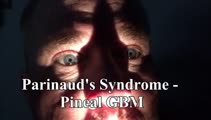 |
Parinaud's Syndrome in a Man with GBM of the Pineal Gland | 𝗢𝗿𝗶𝗴𝗶𝗻𝗮𝗹 𝗗𝗲𝘀𝗰𝗿𝗶𝗽𝘁𝗶𝗼𝗻: This is a 60-yo-man who presented with diplopia, headaches, and difficulty looking up, and was found to have a mass involving the pineal gland. Biopsy was diagnostic of a GBM. Major features of Parinaud's (dorsal midbrain... | Saccades; Convergence; Range; Dorsal Midbrain Syndrome; Convergence Retraction Nystagmus; Upgaze Palsy |
| 210 |
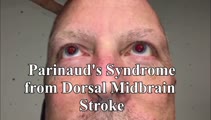 |
Parinaud's Syndrome with Impaired Upward Saccades and Otherwise Normal Vertical Eye Movements | This is a 50-yo-man who suffered a dorsal midbrain stroke. Exam demonstrated normal vertical range of eye movements, normal vertical VOR and smooth pursuit, but inability to perform upward saccades. Another feature of Parinaud's syndrome seen on his exam was light-near dissociation (not shown in thi... | Abnormal Saccades; Range of Eye Movements; Abnormal Range of Eye Movements; Smooth Pursuit; Normal VOR; Dorsal Midbrain Syndrome |
| 211 |
 |
Paroxysmal Ocular Tilt Reaction | 𝗢𝗿𝗶𝗴𝗶𝗻𝗮𝗹 𝗗𝗲𝘀𝗰𝗿𝗶𝗽𝘁𝗶𝗼𝗻: This is a 60-year-old woman who 2 years prior experienced a left sided hypertensive hemorrhagic stroke, resulting in right hemiparesis, dysarthria and vertical diplopia. The initial vertical diplopia resolved completely a... | Midbrain OMS; Skew Deviation; Jerk Nystagmus; Abnormal Alignment |
| 212 |
 |
Pendular Nystagmus | 𝗢𝗿𝗶𝗴𝗶𝗻𝗮𝗹 𝗗𝗲𝘀𝗰𝗿𝗶𝗽𝘁𝗶𝗼𝗻: This is an example of pendular nystagmus, where like jerk nystagmus, the slow phase initiates the movement. However, unlike jerk nystagmus, there is no fast phase, but rather back to back slow phases resembling a pendulum... | |
| 213 |
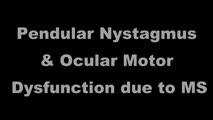 |
Pendular Nystagmus and Ocular Motor Signs in MS | 𝗢𝗿𝗶𝗴𝗶𝗻𝗮𝗹 𝗗𝗲𝘀𝗰𝗿𝗶𝗽𝘁𝗶𝗼𝗻: This is a 30-year-old man with a 15 year history of multiple sclerosis. For the last 12 months, he experienced horizontal oscillopsia. On examination, there were ocular motor abnormalities including gaze-evoked nystagmus,... | Pendular Nystagmus; Jerk Nystagmus; Gaze Evoked Nystagmus; Abnormal Saccades |
| 214 |
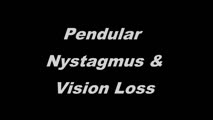 |
Pendular Nystagmus and Vision Loss | Three patients are presented here, each with poor vision (counting fingers or worse) related to retinitis pigmentosa in one patient (Usher's syndrome) and optic neuropathy in two patients, each of whom developed pendular nystagmus after vision loss developed. Visually mediated movements normally pre... | Pendular Nystagmus |
| 215 |
 |
Pendular, Gaze-Evoked and Abducting Nystagmus in MS | This is a 40-year-old woman with a history of multiple sclerosis who presented for oscillopsia. On examination, she had bilateral internuclear ophthalmoplegia (INO-adduction lag OU and abducting nystagmus OU), with a corresponding exotropia that increased in right and left gaze. She also had horiz... | Jerk Nystagmus; INO; Pendular Nystagmus; Abducting Nystagmus; Gaze-Evoked Nystagmus; Cerebellar OMS |
| 216 |
 |
Penlight Cover Test (Partial Removal of Fixation) | Penlight cover test (partial removal of fixation): during in-person clinical encounters, the maneuvers below are best tested with complete (or near complete) removal of fixation (e.g., Frenzel or video Frenzel goggles). Removal of fixation is more challenging during virtual evaluations but can be ap... | Penlight Cover Test (Partial Removal of Fixation) |
| 217 |
 |
Periodic Alternating Nystagmus Due to Nodulus Stroke | This is a 70-year-old woman who experienced the acute onset of vertigo and imbalance. MRI demonstrated a diffusion-weighted imaging hyperintensity involving the nodulus (with corresponding ADC hypointensity) consistent with an acute stroke. On examination several weeks after the stroke, periodic alt... | Periodic Alternating Nystagmus; Jerk Nystagmus |
| 218 |
 |
Periodic Alternating Nystagmus Due to Nodulus Stroke (Figure 1) | This is a 70-year-old woman who experienced the acute onset of vertigo and imbalance. MRI demonstrated a diffusion-weighted imaging hyperintensity involving the nodulus (with corresponding ADC hypointensity) consistent with an acute stroke. On examination several weeks after the stroke, periodic alt... | Periodic Alternating Nystagmus; Jerk Nystagmus |
| 219 |
 |
Periodic Alternating Nystagmus Due to Spinocerebellar Ataxia Type 6 | 𝗢𝗿𝗶𝗴𝗶𝗻𝗮𝗹 𝗗𝗲𝘀𝗰𝗿𝗶𝗽𝘁𝗶𝗼𝗻: This 50-yo-man complained of imbalance for several years and more recently oscillopsia. On examination, there was saccadic pursuit and VOR suppression in addition to gaze-evoked nystagmus with rebound, raising suspicion f... | Cerebellar; Jerk Nystagmus; Periodic Alternating Nystagmus; Gaze Evoked Nystagmus; Rebound Nystagmus |
| 220 |
 |
Periodic Alternating Nystagmus Due to a Chiari Malformation | This patient first experienced oscillopsia 12 months prior to this video. Three months after the onset of symptoms, she was seen by neuro-ophthalmology and found to have a spontaneous, unidirectional left-beating nystagmus (that did not reverse) in addition to saccadic smooth pursuit. Oscillopsia wo... | |
| 221 |
 |
Periodic Alternating Nystagmus and Central Head-Shaking Nystagmus from Nodulus Injury | 𝗢𝗿𝗶𝗴𝗶𝗻𝗮𝗹 𝗗𝗲𝘀𝗰𝗿𝗶𝗽𝘁𝗶𝗼𝗻: This is a 35-year-old man who suffered a gunshot wound to his cerebellum. When he regained consciousness days later, he experienced oscillopsia due to periodic alternating nystagmus (PAN). He was started on baclofen 10 mg... | Jerk Nystagmus; Gaze-Evoked Nystagmus; Abnormal Headshake; Periodic Alternating Nystagmus |
| 222 |
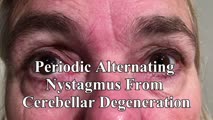 |
Periodic Alternating Nystagmus and Perverted Head-shaking Nystagmus in Cerebellar Degeneration | 𝗢𝗿𝗶𝗴𝗶𝗻𝗮𝗹 𝗗𝗲𝘀𝗰𝗿𝗶𝗽𝘁𝗶𝗼𝗻: This is a 60-yo-woman with several years of worsening imbalance, diplopia (hers was actually unrelated to cerebellar pathology [although she did have an esotropia greater at distance that was cerebellar in origin] and due... | Headshaking; Cerebellar; Jerk Nystagmus; Periodic Alternating Nystagmus |
| 223 |
 |
Peripheral (Vestibular) and Central (Gaze-Evoked) Patterns of Nystagmus in a Single Patient | A 55-year-old man experienced episodic vertigo and was diagnosed with Meniere's disease affecting the left ear (based on audiograms and his clinical course) about 1 year prior to presentation. About 6 months prior to presentation, intratympanic (IT) gentamicin was injected into the left ear, at whic... | Jerk Nystagmus; Vestibular Nystagmus; Bruns; Gaze Evoked Nystagmus; VOR HIT Abnormal |
| 224 |
 |
Physiologic End Point Nystagmus | This is a normal subject with end point nystagmus in lateral gaze. Features that favor physiologic (normal) end point nystagmus (EPN) rather than pathologic gaze-evoked nystagmus include: only present in far lateral gaze (at close to 100% of the normal range of ocular movements); resolves when the v... | Physiologic Nystagmus |
| 225 |
 |
Pinched Nose Valsalva | Valsalva (closed glottis or pinched nose): instruct the patient to take a deep breath and ‘bear down' (closed glottis) or take a deep breath and ‘try to pop their ears' (pinched nose). Assess for nystagmus. In superior canal dehiscence, pressure changes may be transmitted to the superior canal, ... | Pinched Nose Valsalva |
